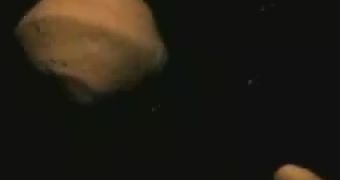In May 2001, scientists have taken plenty of radar images of a pair of asteroids that passed 4.8 million kilometers from Earth. Now they have put together all the information in the form of a movie depicting the motion of the two asteroids. The movie can be seen here.
The asteroids (known as the KW4 system) were first monitored because they were classified as potentially hazardous for Earth. Subsequent observations however have allowed a better estimation of their trajectory and it is now certain they will not cross Earth's orbit in the next 1000 years.
"The KW4 results have profound consequences for ideas about mitigation of the asteroid collision hazard," said Daniel Scheeres, University of Michigan associate professor of aerospace engineering.
The movie is spectacular in many respects, showing the larger asteroid spinning very fast, so fast that its shape is very deformed, and the smaller asteroid rotating around the large one entirely trapped by the gravitational pull. Due to its high speed spinning the "mountains" present in the lower regions of the asteroid are actually at a lower altitude than the equatorial "plains".
According to Scheeres, the asteroid is spinning so fast that the equatorial ridge is very close to lifting off the surface and spinning into space. It's possible that the smaller asteroid was actually a part of the larger one, a part that flew off into space at some moment in time.
Because they have such irregular shapes the asteroids sometimes spin faster and faster when they are illuminated by the Sun. This is known as the YORP effect. Moreover, these observations confirm the fact that asteroids are not solid masses but piles of rubble held together by gravity.
This kind of information would be very relevant if an asteroid would actually head towards Earth. The fact that they are not solid objects means that inflicting a large explosion on one of them - for the purpose of changing its direction - could actually cause a shower of smaller asteroids.

 14 DAY TRIAL //
14 DAY TRIAL //